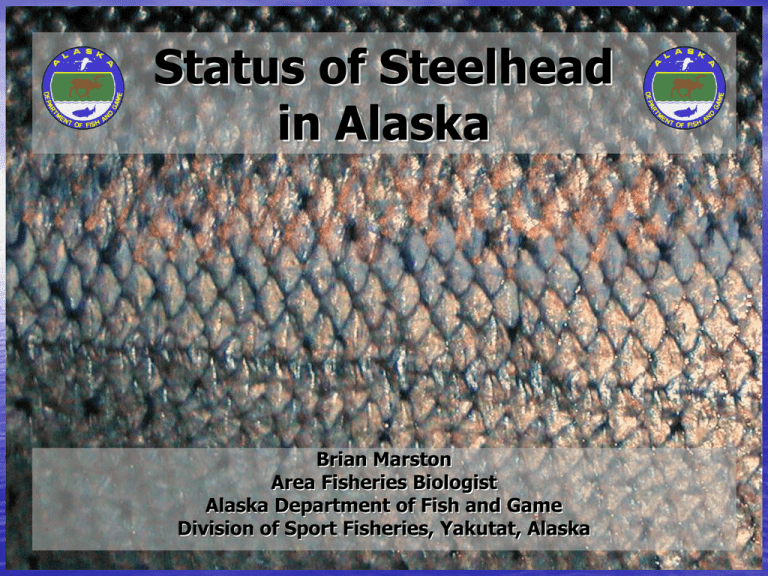ppt
advertisement

Status of Steelhead in Alaska Brian Marston Area Fisheries Biologist Alaska Department of Fish and Game Division of Sport Fisheries, Yakutat, Alaska Presentation Topics • Distribution • Stock Status • Fisheries • Concerns Juneau Anchorage Types of fishery harvest • Sport Fish • Subsistence • Commercial – non sale Sport Fishery Regulations • Southcentral Alaska Harvest Limit: 2 per day ( 1 fish > 20 in.) 2 Annually over 20 in. Spawning area closures Kodiak Road Zone: C&R • Upper Copper River Catch and release Spawning closures • Southeast Alaska Harvest Limit: 1 per day, 2 Annually (> 36 in.) Catch and release Spawning area closures Statewide Harvest Survey; Angling Harvest 800 # of steelhead harvested Southcentral 700 Southeast 600 Total 500 400 300 200 100 0 1999 2000 2001 2002 2003 2004 2005 2006 2007 2008 Statewide Catch Survey; Angling Catch # of steelhead caught 50,000 45,000 Southcentral 40,000 Southeast 35,000 Total 30,000 25,000 20,000 15,000 10,000 5,000 0 1999 2000 2001 2002 2003 2004 2005 2006 2007 2008 Subsistence Harvest 700 ADF&G (1997) Harvest Estimates for Craig, Hydaburg, and Klawock 609 # of steelhead harvested 600 500 400 300 200 Harvest Recorded on Federal Permits 100 34 37 37 49 2003 2004 2005 2006 31 36 36 2007 2008 2009 0 1997 08 05 02 99 96 93 90 87 84 81 78 75 72 69 66 63 60 2,000 20 20 20 19 19 19 19 19 19 19 19 19 19 19 19 19 19 Reported steelhead harvests in commercial fisheries Commercial Steelhead Harvest in Southeast Alaska 12,000 10,000 8,000 6,000 4,000 Sale Prohibited 0 Stock Status Assessment • Snorkel Surveys • Weir counts Kelts and or adults upstream – Scale pattern ageing; PIT tags – Length sampling – DIDSON Sonar applications Southeast Alaska Steelhead Index Streams Normalized Counts of Steelhead, Southeast Alaska 200% Deviation from Median Count 150% Peterson Creek Pleasant Bay (Seymour) McDonald Lake White River Petersburg Creek Harris River Eagle/Luck Creek Ford Arm Creek Sitkoh Creek Average for all Streams 100% 50% 0% 1997 -50% -100% 1998 1999 2000 2001 2002 2003 2004 2005 2006 2007 2008 2009 Sitkoh Creek Weir Counts – Southeast Alaska 800 Number of Steelhead kelts 700 759 690 672 660 600 538 520 500 424 408 2008 2009 386 400 343 354 300 296 200 169 100 0 1982 1990 1993 2003 2004 2005 2006 2007 Sashin Creek Weir Counts, Southeast Alaska 80 75 Number of Steelhead Kelts 70 60 47 50 40 30 36 29 35 28 21 20 15 12 9 10 0 2000 2001 2002 2003 2004 2005 2006 2007 2008 2009 Situk River Weir Counts – Southeast Alaska Number of Steelhead Kelts 16,000 15,003 14,000 12,462 12,265 12,438 12,000 10,000 7,964 8,000 7,312 7,302 6,709 6,400 6,113 6,000 4,000 2,000 0 2000 2001 2002 2003 2004 2005 2006 2007 2008 2009 Litnik Weir Counts – Kodiak Area Number of Steelhead Kelts 450 383 400 350 310 316 300 250 200 150 100 221 185 118 67 63 80 59 50 0 2000 2001 2002 2003 2004 2005 2006 2007 2008 2009 Karluk Weir Counts – Kodiak Area 2,500 2,376 Number of Steelhead Kelts 2,147 2,000 1,879 1,775 1,501 1,518 1,500 1,429 1,366 1,265 954 1,000 500 0 2000 2001 2002 2003 2004 2005 2006 2007 2008 2009 Ayakulik Weir Counts – Kodiak Area 1, 4 0 0 1,148 1,090 Number of Steelhead Kelts 1, 2 0 0 995 1, 0 0 0 827 790 769 800 591 600 319 342 400 200 93 0 2000 2001 2002 2003 2004 2005 2006 2007 2008 2009 Length attribute sampling Average total length (mm) of steelhead from the Situk River 2000-2009 1,200 Male 1,100 1,000 900 800 700 600 20 00 20 01 20 02 20 03 20 04 20 05 20 06 20 07 20 08 20 09 Average total length of Steelhead Female Scale Pattern Analysis DIDSON sonar • Pros – No weir across river to impact fishery – Recordable data countable by computer – Less technicians in field – Observable images of data for public • Cons – – – – Expense Expertise No species recognition Requires power • Total data loss if failure Management Concerns: Habitat Degradation • Roads • Hydroelectric Projects • Timber Harvest Management • Mining Projects Undocumented harvest in commercial and subsistence fisheries. Future management directions • More stock status data needed • Continue long term datasets • Creating habitat suitability models for SE streams • Preemptive Management • Trout management plan • Protection of habitat • Maintain size and age attributes • Emphasize importance of fishery Conclusion: Questions? • Current conservative regulations provide for sustainability of steelhead stocks while allowing for a limited sport fishery. • Sport fishery catch rates remain high and all harvests low • Current abundances of steelhead in the assessed streams of Alaska appear to be within normal variation • Some SE streams have declined from recent high abundance, while SC streams are at average or peak abundance after recent low counts. • Sustainable fisheries, habitat conservation and maintenance of current stock attributes remains the primary focus.











